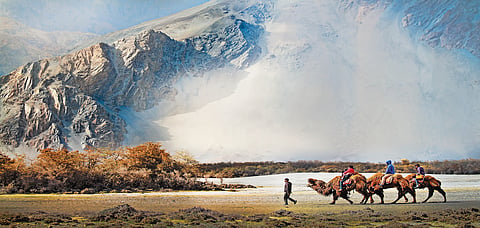
- Destinations
- Experiences
- Stay
- What's new
- Celebrating People
- Responsible Tourism
- CampaignsCampaigns
- SubscribeSubscribe
- Buy Now

There was no gale that morning, and the sea was far, far away. In fact the Himalayan Pass of Nathu La is 18,380 feet above sea level, according to its board. But, apart from such factual information, whenever we discuss a project the floodgates of our minds spring open releasing a virtual storm of, often conflicting, ideas. This surge of creative Spindrift is the working capital of our writing. When we entered travel writing we thought, as many people do today, that it was nothing more than a description of going there and doing that. Then, a good, but very outspoken, friend said, &ldquoYour descriptions are great. But any high- school kid can do that. We want more from the two of you. We want to know Who How When What Why&rdquo We took him seriously and, very assiduously, amassed credible sources of information. Today, our personal library has books on subjects ranging from art and archaeology through literature and music to zoology and zen.
We learnt that the la in NathuLa was a pass and that there were many such passes in the Himalayas. All through the ages, men had trudged through them. These travellers and their double- humped Bactrian, cold-desert, camels, had established many ancient trading routes, including one of the branches of the famed Silk Road. According to Dr. Peggy Mohan&rsquos book, Wanderers, Kings, Merchants &ndash the Story of India through its languages, the Vedic people had also filtered into India as small groups of men, married Indian women, and their families were responsible for preserving Sanskrit as a male-centric religious and ritualistic language. Their wives and children spoke a hybrid tongue called Prakrit. Later, as more immigrants added their vocabulary to our linguistic pool, it evolved into urdu and, finally, hindi. If we had read this wonderful book before we left NathuLa we might have been more enriched by our experience, but even with our limited knowledge, we had plenty to fascinate us as we wound down the back of the Himalayas.
It was a narrow, snow-bound, ice- sparkling, road. Water dripping from black rocks had frozen into bizarre shapes hobgoblins and dwarves with elongated fangs and hunched backs. Through this frozen fantasy wandered black, shaggy yaks as if the cold boulders had ponderously awoken to life.
We were glad to leave this frigid black- and-white land and wind into a valley where a blue river meandered through crystal sand that crunched under our tyres. In the distance the dark Karakoram stretched as if to remind us that we were still in the realm of myths and legends. Our guide said, &ldquoYou see that stone house on top of that hill&rdquo The house stood sharp and craggy atop a black, peaked rock heraldic against the sunset glow of the sky. &ldquoAn ogre once lived there. He ate little children.&rdquo Our skins wrinkled in horror. We were back in the Dark Lord&rsquos domain and dusk was closing in
The people of the Nubra Valley are Buddhists but their faith is still influenced by the pre-Buddhist animistic cult of Bon. If a place, in this wild terrain, is particularly prone to accidents, then it must be haunted by an evil spirit. To ward off its malign power travellers should throw a stone at that spot. In course of time this pile of stones becomes a chorten and local folk plant a shrub on it, richer believers in the wayside spirit, convert the chorten into a formal, masonry, stupa and the evolution from Bon to Buddhism is complete.
More importantly, evidence of their Central Asian links survives. Double humped Bactrian camels, still chomp phlegmatically at the oddly sustaining Sea Buckthorn. Defence scientists supply extracts of its berries to our frontline troops. Saltpetre, an essential ingredient of churned Yak butter tea, emerges from low-lying wetlands. And though a smiling housewife graciously allowed us to take a cutting of an overpoweringly fragrant deep pink rose they call skangba, she also advised us, &ldquoMy daughter, in Mussoorie, has tried many times.&rdquo Then she added that if we wanted the fragrance of Nubra we had to come to Nubra.
She was right.
